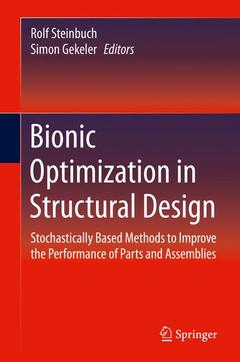Bionic Optimization in Structural Design, Softcover reprint of the original 1st ed. 2016 Stochastically Based Methods to Improve the Performance of Parts and Assemblies

The book provides suggestions on how to start using bionic optimization methods, including pseudo-code examples of each of the important approaches and outlines of how to improve them. The most efficient methods for accelerating the studies are discussed. These include the selection of size and generations of a study?s parameters, modification of these driving parameters, switching to gradient methods when approaching local maxima, and the use of parallel working hardware.
Bionic Optimization means finding the best solution to a problem using methods found in nature. As Evolutionary Strategies and Particle Swarm Optimization seem to be the most important methods for structural optimization, we primarily focus on them. Other methods such as neural nets or ant colonies are more suited to control or process studies, so their basic ideas are outlined in order to motivate readers to start using them.
A set of sample applications shows how Bionic Optimization works in practice. From academic studies on simple frames made of rods to earthquake-resistant buildings, readers follow the lessons learned, difficulties encountered and effective strategies for overcoming them. For the problem of tuned mass dampers, which play an important role in dynamic control, changing the goal and restrictions paves the way for Multi-Objective-Optimization. As most structural designers today use commercial software such as FE-Codes or CAE systems with integrated simulation modules, ways of integrating Bionic Optimization into these software packages are outlined and examples of typical systems and typical optimization approaches are presented.
The closing section focuses on an overview and outlook on reliable and robust as well as on Multi-Objective-Optimization, including
discussions of current and upcoming research topics in the field concerning a unified theory for handling stochastic design processes.Professor Rolf Steinbuch, University of Reutlingen,
1977-1982 Fracture mechanics / safety analysis KWU/SIEMENS, Erlangen,
1982-1983 Design of Desalination plants BTB Leonberg
1984-1993 Simulation of car components at DaimlerChrysler Untertürkheim
since 1993 Professor (C3) Mathematics. Simulation and Mechanics at Reutlingen University, Dep. of Engineering
Simon Gekeler, University of Reutlingen
since 2011 Design optimization/sensitivity analysis, evaluation of design robustness and reliability, algorithm development Reutlingen Research Institute, Reutlingen University.Focus on the optimization of high-dimensional problems
Easily applicable by pseudo-code examples
Practical implementation and application
Includes supplementary material: sn.pub/extras
Date de parution : 02-2018
Ouvrage de 160 p.
15.5x23.5 cm
Date de parution : 11-2015
Ouvrage de 160 p.
15.5x23.5 cm
Thème de Bionic Optimization in Structural Design :
Mots-clés :
Bionic Optimization; CAE-processes; Deterministic Optimization Gradient methods; Evolutionary Approaches; Evolutionary Optimization; Gradient Methods; Neural Nets; Optimization; Optimization in Metal Forming; Particle Swarm Optimization; Simulation; Structural Optimization; Tuned Mass Dampers; Virtual Product Development
